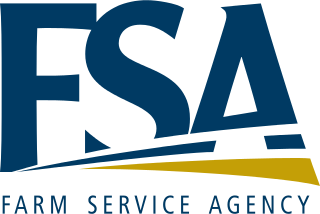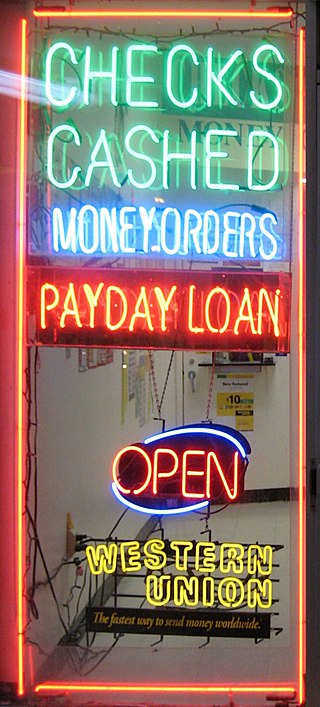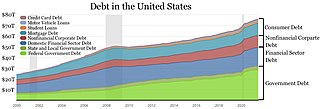Related Research Articles

In finance, a loan is the lending of money by one or more individuals, organizations, or other entities to other individuals, organizations, etc. The recipient incurs a debt and is usually liable to pay interest on that debt until it is repaid as well as to repay the principal amount borrowed.

Debt consolidation is a form of debt refinancing that entails taking out one loan to pay off many others. This commonly refers to a personal finance process of individuals addressing high consumer debt, but occasionally it can also refer to a country's fiscal approach to consolidate corporate debt or government debt. The process can secure a lower overall interest rate to the entire debt load and provide the convenience of servicing only one loan or debt.

A student loan is a type of loan designed to help students pay for post-secondary education and the associated fees, such as tuition, books and supplies, and living expenses. It may differ from other types of loans in the fact that the interest rate may be substantially lower and the repayment schedule may be deferred while the student is still in school. It also differs in many countries in the strict laws regulating renegotiating and bankruptcy. This article highlights the differences of the student loan system in several major countries.

The Farm Service Agency (FSA) is the United States Department of Agriculture agency that was formed by merging the farm loan portfolio and staff of the Farmers Home Administration (FmHA) and the Agricultural Stabilization and Conservation Service (ASCS). The Farm Service Agency implements agricultural policy, administers credit and loan programs, and manages conservation, commodity, disaster, and farm marketing programs through a national network of offices. The Administrator of FSA reports to the Under Secretary of Agriculture for Farm Production and Conservation. The current Administrator is Zach Ducheneaux. The FSA of each state is led by a politically appointed State Executive Director (SED).
Refinancing is the replacement of an existing debt obligation with another debt obligation under a different term and interest rate. The terms and conditions of refinancing may vary widely by country, province, or state, based on several economic factors such as inherent risk, projected risk, political stability of a nation, currency stability, banking regulations, borrower's credit worthiness, and credit rating of a nation. In many industrialized nations, common forms of refinancing include primary residence mortgages and car loans.

A payday loan is a short-term unsecured loan, often characterized by high interest rates.
A home equity line of credit, or HELOC, is a revolving type of secured loan in which the lender agrees to lend a maximum amount within an agreed period, where the collateral is the borrower's property. Because a home often is a consumer's most valuable asset, many homeowners use their HELOC for major purchases or projects, such as home improvements, education, property investment or medical bills, and choose not to use them for day-to-day expenses.
The Commodity Credit Corporation (CCC) is a wholly owned United States government corporation that was created in 1933 to "stabilize, support, and protect farm income and prices". The CCC is authorized to buy, sell, lend, make payments, and engage in other activities for the purpose of increasing production, stabilizing prices, assuring adequate supplies, and facilitating the efficient marketing of agricultural commodities.

A commercial mortgage is a mortgage loan secured by commercial property, such as an office building, shopping center, industrial warehouse, or apartment complex. The proceeds from a commercial mortgage are typically used to acquire, refinance, or redevelop commercial property.
A loan guarantee, in finance, is a promise by one party to assume the debt obligation of a borrower if that borrower defaults. A guarantee can be limited or unlimited, making the guarantor liable for only a portion or all of the debt.
The Farm Credit System (FCS) in the United States is a nationwide network of borrower-owned lending institutions and specialized service organizations. The Farm Credit System provides more than $304 billion in loans, leases, and related services to farmers, ranchers, rural homeowners, aquatic producers, timber harvesters, agribusinesses, and agricultural and rural utility cooperatives.
The Federal Family Education Loan (FFEL) Program was a system of private student loans which were subsidized and guaranteed by the United States federal government. The program issued loans from 1965 until it was ended in 2010. Similar loans are now provided under the Federal Direct Student Loan Program, which are federal loans issued directly by the United States Department of Education.
The William D. Ford Federal Direct Loan Program provides "low-interest loans for students and parents to help pay for the cost of a student's education after high school. The lender is the U.S. Department of Education ... rather than a bank or other financial institution." It is the largest single source of federal financial aid for students and their parents pursuing post-secondary education and for many it is the first financial obligation they incur, leaving them with debt to be paid over a period of time that can be a decade or more as the average student takes 19.4 years. The program is named after William D. Ford, a former member of the U.S. House of Representatives from Michigan.
Graduate PLUS is a type of federal student aid, in the form of student loans, which is available to graduate and professional students. Similar to the Parent PLUS loan for parents of dependent undergraduate students, the Graduate PLUS loan is an unsubsidized federally guaranteed education loan with no annual or aggregate limits. It has no grace period and it goes into repayment as soon as the funds are disbursed to the borrower. It has the same deferment and forbearance options as the federal Stafford loan program. As such, graduate and professional students can postpone repayment using in-school deferment while enrolled at least half-time in a degree or certificate program of study.

A mortgage loan or simply mortgage, in civil law jurisdicions known also as a hypothec loan, is a loan used either by purchasers of real property to raise funds to buy real estate, or by existing property owners to raise funds for any purpose while putting a lien on the property being mortgaged. The loan is "secured" on the borrower's property through a process known as mortgage origination. This means that a legal mechanism is put into place which allows the lender to take possession and sell the secured property to pay off the loan in the event the borrower defaults on the loan or otherwise fails to abide by its terms. The word mortgage is derived from a Law French term used in Britain in the Middle Ages meaning "death pledge" and refers to the pledge ending (dying) when either the obligation is fulfilled or the property is taken through foreclosure. A mortgage can also be described as "a borrower giving consideration in the form of a collateral for a benefit (loan)".

Student loans in the United States are a form of financial aid intended to help students access higher education. In 2018, 70 percent of higher education graduates had used loans to cover some or all of their expenses. With notable exceptions, student loans must be repaid, in contrast to other forms of financial aid such as scholarships, which are not repaid, and grants, which rarely have to be repaid. Student loans may be discharged through bankruptcy, but this is difficult.

In United States federal agriculture legislation, the Agricultural Credit Act of 1987 was enacted in response to the severe financial crisis of the early- to mid-1980s, which affected both farmers and their lending institutions.
Section 502 loans are a rural housing loan program, administered by the Rural Housing Service (RHS), authorized under Section 502 of the Housing Act of 1949. Borrowers may obtain loans for purchasing or repairing new or existing single-family housing. Loans are made directly by RHS or by private lenders with a USDA guarantee. Borrowers with income of 80% or less of the area median may be eligible for 33- year direct loans and may receive payment assistance to bring the interest rate to as low as 1%. In a given fiscal year, at least 40% of the units financed under this section must be made available only to very low-income families or individuals. In addition, families or individuals at or below 60% of the area median may qualify for loan terms up to 38 years. Borrowers must have the means to repay the loans, but be unable to secure reasonable credit terms elsewhere. Borrowers with income of up to 115% of the area median may be eligible for 30-year guaranteed loans from private lenders. Priority is given to first-time home buyers, and the RHS may require that borrowers complete a home ownership counseling program.
The Consolidated Farm and Rural Development Act, authorizes the Farm Service Agency to make direct and guaranteed farm ownership loans to eligible family farmers.
Zidisha allows people to lend small amounts of money directly to entrepreneurs in developing countries. It is the first peer-to-peer microlending service to link borrowers and lenders across international borders without a local microfinance institution intermediary. The organization is named after the Swahili word zidisha, which means "grow" or "expand".
References
- ↑ "Farm Operating Loans". national-content. 2016-12-29. Retrieved 2022-11-21.
- ↑ "Farm Operating Loans (Direct and Guaranteed)". www.govloans.gov. Retrieved 2016-12-29.
![]() This article incorporates public domain material from Jasper Womach. Report for Congress: Agriculture: A Glossary of Terms, Programs, and Laws, 2005 Edition (PDF). Congressional Research Service.
This article incorporates public domain material from Jasper Womach. Report for Congress: Agriculture: A Glossary of Terms, Programs, and Laws, 2005 Edition (PDF). Congressional Research Service.